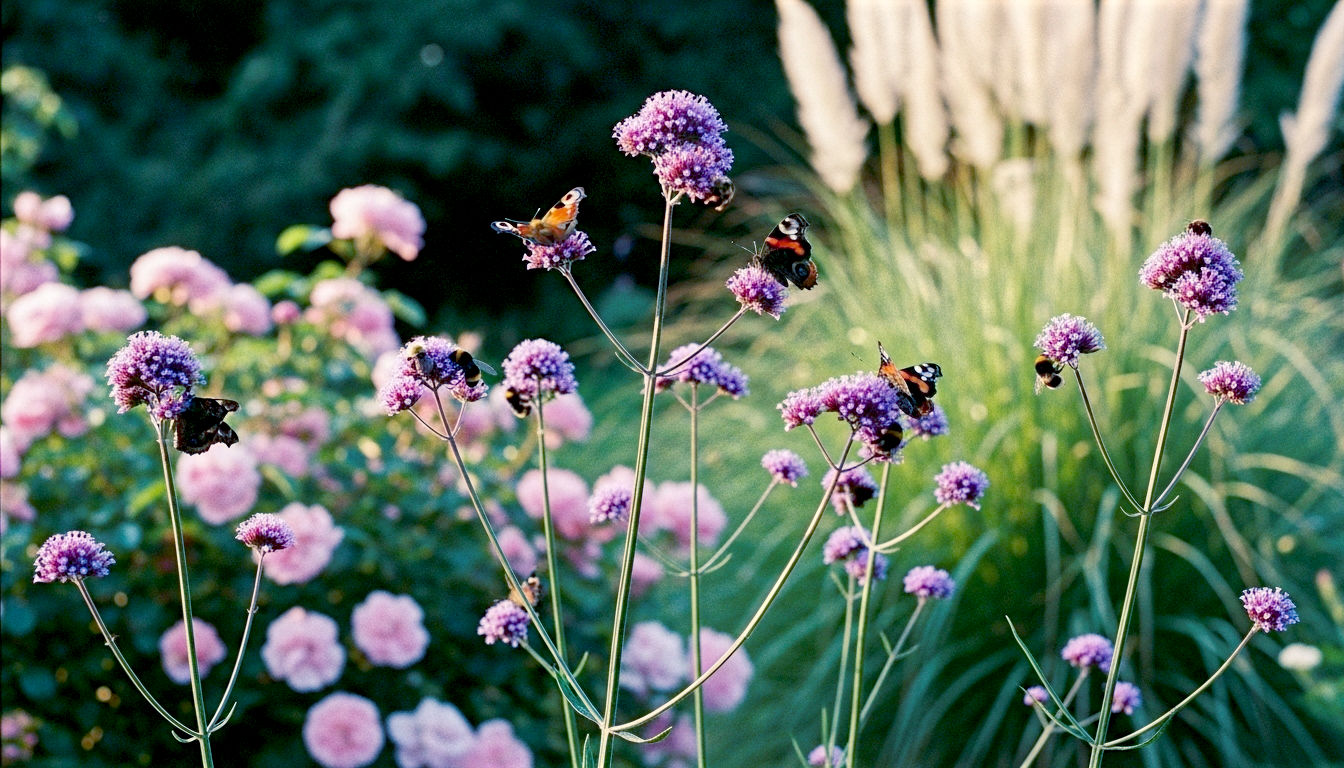The Guide to Verbena: From Ancient Magic to the Modern British Garden
Our complete guide to verbena explores its rich history, popular types, and surprising uses. Learn how to grow this versatile plant in the UK.

This post may contain affiliate links. If you make a purchase through these links, we may earn a commission at no additional cost to you.
Right then, let’s talk about Verbena. You’ve almost certainly seen it, even if you didn’t know what it was called. Picture a classic British garden in late summer. Bees are buzzing lazily, butterflies are flitting about, and dancing above the roses and lavender are tall, wiry stems topped with clusters of tiny, brilliant purple flowers. That’s very likely Verbena bonariensis, the unassuming superstar of modern garden design.
But that’s just one small part of the story. Verbena is so much more than a single pretty plant. It’s a huge family with a history that stretches back thousands of years, woven into ancient rituals, folklore, and medicine cabinets. It’s a secret ingredient for chefs, a soothing balm in a teacup, and a colourful workhorse for hanging baskets that brighten up pub gardens from Cornwall to the Cairngorms.
For too long, this incredible plant has been misunderstood or simply overlooked. Many gardeners think of it as just one thing—either the tall, airy type or the low-growing bedding plant. But its versatility is its true magic. It’s a plant that can be elegant and wild, or neat and vibrant. It can be a healer, a flavouring, and a magnet for precious wildlife.
This is the ultimate guide to verbena for anyone in Britain. We’ll dig into its fascinating past, meet the most important members of the family, and give you practical, no-nonsense advice on how to grow it in our unique climate. Forget everything you thought you knew. It’s time to discover the true, astonishing versatility of verbena.
What Exactly Is Verbena? A Simple Introduction
Before we get carried away, let’s clear something up. When people say “verbena,” they could be talking about one of over 250 different species in a huge plant family called Verbenaceae. Think of it like the Rose family, which includes everything from massive climbing roses to the apples and pears you grow on your allotment.
For gardeners and herb lovers in the UK, though, we can thankfully narrow it down to a few key players. But they all share a few family traits.
A Simple Explanation: Verbena is a group of plants known for their tough nature and long flowering season. Most have simple, often rough-feeling leaves and clusters of small flowers. Some grow tall and thin, others spread out to cover the ground, and one famous cousin smells powerfully of lemon sherbet.
A More Detailed Explanation: Many verbena species have distinctive square-shaped stems, which is a clue that they’re related to the mint family. Their leaves are often arranged in opposite pairs along the stem. The flowers, though small individually, are packed together in dense clusters or spikes called inflorescences. These flower heads are what give the plant its visual punch and make them so attractive to pollinators.
The most important thing for any British gardener to understand is the difference between hardy and tender verbenas.
- Hardy Verbenas: These are the tough ones that can survive a typical British winter outdoors, although they might need a bit of protection in very cold parts of the country. The famous tall Verbena bonariensis fits in this group, as does our native wild verbena.
- Tender Verbenas: These are more delicate types that originally came from warmer climates. They can’t handle frost and are usually grown as annuals in the UK—meaning they live for just one season. These are the vibrant, often multi-coloured verbenas you buy as bedding plants in spring for your pots and hanging baskets. The wonderful Lemon Verbena is also in this camp.
Understanding this distinction is the key to success. There’s nothing more disappointing than watching a beautiful plant you thought was permanent get zapped by the first autumn frost.
A Potted History: Verbena’s Journey Through Time
Verbena isn’t a new-fangled trend from the Chelsea Flower Show; it’s an ancient herb with a past steeped in magic, medicine, and myth. Its original common name in Europe was Vervain, a word that still carries a whisper of enchantment.
The Ancient World: Tears of Isis and Roman Altars
The story starts in the ancient world. The Egyptians linked vervain to the tears of their goddess Isis, shed as she mourned her murdered husband, Osiris. They believed it was a divine herb, capable of powerful magic.
The Romans were also huge fans. They called it herba sacra, the sacred herb. They used it to purify their homes and temples, sweeping the altars with bundles of vervain before making sacrifices. Roman soldiers even carried it with them, believing it would protect them from harm. It was a plant of peace, too; ambassadors wore crowns of vervain when they went to discuss treaties, as it was thought to promote diplomacy and truth.
Druids and Dark Ages: The Herb of Enchantment
Here in Britain, vervain was a cornerstone of the Celtic Druids’ belief system. They considered it one of their most sacred plants, gathering it with great ceremony, often at twilight or dawn when the stars were hidden. They used it in potions and rituals for divination and protection.
This reputation as a magical protector continued long after the Druids. Throughout the medieval and Tudor periods, vervain was hung over doorways to ward off evil spirits and witches. It was a key ingredient in folk remedies and love potions, believed to be able to mend broken hearts and rekindle lost love. It was even thought to make the wearer immune to harm, which is why it was sometimes called the “herb of grace.”
From Tudor Gardens to Victorian Bouquets
In the more organised gardens of monasteries and castles, our native Common Vervain (Verbena officinalis) was a staple in the herb garden. It wasn’t grown for its beauty—it’s a fairly scruffy-looking plant—but for its uses. It was prescribed for everything from headaches and anxiety to kidney stones.
Later, in the Victorian era, new, more colourful species of verbena began to arrive from the Americas. These showy flowers became popular in the elaborate bedding schemes of the time. In the secret “language of flowers” so beloved by the Victorians, giving someone a verbena flower meant “pray for me” or “you have my sympathy.”
The Modern Revival: A Chelsea Flower Show Favourite
For much of the 20th century, verbena was mostly seen as a cheerful but slightly old-fashioned bedding plant. That all changed in the late 1990s with the rise of the “New Perennial” or “Naturalistic” planting movement, championed by garden designers like the Dutchman Piet Oudolf.
He and others fell in love with Verbena bonariensis. Its tall, see-through structure was perfect for creating a dreamy, hazy effect in borders. It added height and colour without blocking the plants behind it. Suddenly, this once-overlooked plant was the star of the show at the RHS Chelsea Flower Show and started appearing in stylish gardens across the country. This revival cemented verbena’s place not just as a humble herb, but as a modern design classic.
Meet the Family: The Most Popular Verbena Varieties in the UK
While the verbena family is huge, there are four main groups you’re likely to come across in a British garden centre or nursery. Getting to know them is the first step to choosing the right one for your garden.
The Star of the Show: Verbena bonariensis
This is the one everyone’s talking about. It’s tall, sometimes reaching 6 feet, with stiff, branching stems that have very few leaves. At the top, it carries flat heads of vibrant lilac-purple flowers from mid-summer right through to the first frosts.
- What it is: A short-lived perennial. It might only live for a few years, but it self-seeds politely around the garden, so you’ll always have new plants popping up.
- Best for: Adding height and a light, airy feel to borders. It looks fantastic planted in drifts among grasses, roses, and other perennials like Echinacea and Rudbeckia. Because it’s so slender, you can see through it, making it perfect for the middle or even the front of a border. It’s a magnet for bees and butterflies.
- Growing Tips: Loves sun and well-drained soil. It’s surprisingly drought-tolerant once it gets going. It doesn’t need staking, despite its height.
The Classic Healer: Common Vervain (Verbena officinalis)
This is our native verbena, the one the Druids used. You might find it growing wild in chalky grasslands in the south of England. It’s much more modest than its South American cousin.
- What it is: A hardy perennial with a sprawling habit. It has wiry stems and produces delicate spikes of tiny, pale lilac flowers.
- Best for: Wildlife gardens, wildflower meadows, and herb gardens. It’s not really a showstopper, but it’s fantastic for attracting pollinators and has a rich history.
- Growing Tips: Very easy to grow. It thrives on neglect in poor, well-drained soil and full sun. Don’t over-fertilise it.
The Scent Sensation: Lemon Verbena (Aloysia citrodora)
This one is a bit of a cheat, as it’s technically a close cousin, not a true verbena. But everyone knows and grows it as one. Its party trick is its leaves, which release the most incredible, intense lemon sherbet scent when you brush past or crush them.
- What it is: A tender woody shrub. In its native South America, it can grow into a small tree. In the UK, it needs serious winter protection.
- Best for: Growing in a pot on a sunny patio where you can enjoy the scent. It’s a must-have for any herb garden or for anyone who loves making their own herbal teas.
- Growing Tips: It needs a big pot, full sun, and regular watering and feeding in summer. In autumn, you must bring it into a frost-free place like a greenhouse, conservatory, or even a porch. Prune it back hard in spring to keep it bushy.
The Colourful Cascaders: Trailing and Bedding Verbenas
This is the verbena of hanging baskets, window boxes, and summer bedding schemes. These are modern hybrids, bred for their huge colour range and incredible flowering performance.
- What it is: Tender annuals that flower their hearts out from late spring until the first frosts. They come in almost every colour imaginable—rich purples, bright pinks, scarlets, whites, and even peachy tones.
- Best for: Providing a massive splash of colour in containers. Their trailing habit is perfect for spilling over the edges of pots and baskets. They create a lush, full look all summer long.
- Growing Tips: Buy them as young plants from the garden centre in late spring. Plant them in good quality peat-free compost with some slow-release fertiliser. They need sun, regular watering, and weekly feeding with a liquid tomato feed to keep them flowering. Deadheading (snipping off the faded flower clusters) is the secret to keeping them going all season.
A Gardener’s Guide: How to Grow Glorious Verbena in Britain
One of the best things about verbena is that it’s generally not a fussy plant. Give it the basics, and it will reward you with months of colour. Here’s a season-by-season guide to keeping it happy in the UK.
Getting Started: Seed or Plant?
For the tender, trailing verbenas, it’s easiest to buy young plants from a garden centre in May or June. They’re cheap and ready to go.
For Verbena bonariensis, you can do either. Buying a few plants is a quick way to get started. But growing from seed is incredibly cheap and easy. The seeds often need a period of cold to kickstart them into growing, a process called stratification. You can do this by sowing them in a tray in autumn and leaving it outside over winter, or by popping the sown tray in the fridge for a few weeks in spring.
The Perfect Spot: Sun, Soil, and Situation
There is one golden rule for almost all verbenas: they must have sun. At least six hours of direct sun a day is ideal. They will get leggy and refuse to flower properly in the shade.
The second rule is well-drained soil. Verbenas hate sitting in cold, wet soil, especially in winter. This is what often kills the hardier types. If you have heavy clay soil, you can improve it by digging in plenty of grit and organic matter (like garden compost) before planting. For pots, make sure you use a good compost mix with added grit or perlite for drainage.
Planting and Care Through the Seasons
- Spring: Plant out hardy verbenas like V. bonariensis after the last frost, usually in late April or May. If you’ve grown tender verbenas from seed or have overwintered your Lemon Verbena, don’t be tempted to put them out too early. Wait until late May or even early June, once the weather is reliably warm.
- Summer: Water your potted verbenas regularly, especially during dry spells. Those in the ground are much more drought-tolerant once established. Feed your container verbenas weekly with a high-potash feed (like tomato food) to encourage more flowers. Deadhead the trailing types by snipping off spent flower heads. V. bonariensis doesn’t really need deadheading.
- Autumn: This is when the big debate happens. Should you cut back your Verbena bonariensis? The answer is no. Leave the dead stems standing over winter. They provide a bit of frost protection for the plant’s crown and look wonderfully skeletal and frosty on a cold morning. The standing stems also provide shelter for insects like ladybirds.
- Winter: For tender verbenas in pots, winter is the end of the line. Simply pop them on the compost heap. Your Lemon Verbena must be brought into a frost-free place. Water it sparingly over winter. For hardy verbenas in the ground, you can add a mulch (a thick layer of bark chips or dry compost) around the base of the plant for extra insulation, especially in colder parts of the UK. Cut back the old, dead stems of V. bonariensis in late spring, once you see new green shoots appearing at the base.
Common Problems and How to Solve Them
Verbena is pretty robust, but there’s one issue that can plague it, especially the trailing varieties: powdery mildew.
This is a fungal disease that looks like a dusting of white powder over the leaves. It’s most common in warm, humid weather and when the plants are stressed.
- How to prevent it: The best cure is prevention. Give your plants plenty of space for air to circulate around them. Don’t cram too many into one pot. Water the soil, not the leaves, and try to water in the morning so the foliage can dry before nightfall.
- How to treat it: If you see it, snip off the affected leaves immediately. In bad cases, you might need to use a fungicide spray, but improving air circulation is usually the best long-term fix.
Aphids can also be a nuisance. You can often just squish them with your fingers or blast them off with a jet of water from the hose.
Beyond the Garden: The Surprising Uses of Verbena
Verbena’s versatility truly shines when you take it out of the flower border and into the home.
In the Kitchen: A Chef’s Secret Weapon
The star of the culinary verbena world is, without a doubt, Lemon Verbena. Its flavour is like a supercharged lemon, but without the acidity. It’s clean, fragrant, and wonderfully refreshing.
- Verbena Tea: This is the easiest and most popular use. Just pop a few fresh leaves into a mug, pour over hot water, and let it steep for 5 minutes. It’s naturally caffeine-free and has a wonderfully calming effect, making it a perfect bedtime drink.
- In Desserts: The flavour works beautifully in milky desserts. You can infuse the leaves in milk or cream to make Lemon Verbena panna cotta, ice cream, or custards.
- Infused Sugar & Syrups: Layer fresh leaves with caster sugar in a jar and leave it for a week. The sugar will absorb the lemon scent and can be used in baking. You can also make a simple sugar syrup and infuse it with the leaves to use in cocktails or to drizzle over fruit salad.
Our native Common Vervain is much more bitter and isn’t really used in modern cooking, though historically it was used to flavour beers and liqueurs.
In the Apothecary: A History of Healing
Disclaimer: This information is for historical and educational purposes only. Always consult a doctor or qualified medical herbalist before using herbs for medicinal reasons.
Vervain has been a cornerstone of European herbal medicine for centuries. It was traditionally known as a nervine, an herb that helps to calm and restore the nervous system.
- Traditional Uses: Herbalists used it to treat anxiety, stress, insomnia, and nervous exhaustion. It was also considered a good digestive tonic, helping to soothe indigestion and bloating. Its slightly bitter properties were thought to stimulate liver function.
- Modern Uses: Today, you can still buy vervain tea or tinctures from herbal suppliers. It’s mostly used for its calming properties, to ease tension and promote sleep. Aromatherapists also use verbena essential oil (often a blend of different types) in diffusers and massage oils to create a relaxing atmosphere.
In the Home: Fragrance and Beauty
The clean, fresh scent of verbena, especially lemon verbena, has made it a favourite in the world of home fragrance and beauty products. French brand L’Occitane en Provence has a world-famous verbena range, and many British artisan soap makers and candle companies use its uplifting scent.
You can easily make your own fragrant products at home. Dry the leaves of Lemon Verbena and add them to potpourri bowls or sew them into small cloth bags to make scented sachets for your drawers and wardrobes.
Verbena in British Culture: More Than Just a Plant
Verbena has quietly woven itself into the fabric of modern British life, influencing everything from our gardens to our wildlife.
A Pollinator’s Paradise: Why Bees and Butterflies Love It
In an age where we are all more aware of the plight of our pollinators, verbena is a true eco-warrior. The flat, open flower clusters of Verbena bonariensis are the perfect landing pad for butterflies like the Peacock, Red Admiral, and Small Tortoiseshell. Bees, hoverflies, and moths also flock to it.
By planting verbena, you are essentially setting up a service station for these vital insects, providing a rich source of nectar late into the season when other flowers are starting to fade. It’s one of the easiest and most effective things a gardener can do to support local biodiversity.
Design Inspiration: The “New Perennial” Movement
As we mentioned, Verbena bonariensis is the poster child for a whole style of gardening. This movement, hugely popular in Britain, is about creating gardens that look more natural, are lower-maintenance, and work in harmony with nature. Instead of neat blocks of colour, it’s about mixing grasses and perennials together to create soft, swaying, painterly effects. Verbena is the perfect plant for this—it’s informal, it moves beautifully in the wind, and it self-seeds to create happy accidents, blurring the hard edges of a garden.
Conclusion: The Enduring Charm of a Humble Herb
From a sacred herb on a Roman altar to the darling of the Chelsea Flower Show, verbena has had a truly remarkable journey. It’s a plant that has been a protector, a healer, a flavouring, and a source of beauty for thousands of years.
Its true genius lies in its versatility. It can be the tough, vibrant bedding plant that brings cheer to a concrete balcony, or the elegant, see-through perennial that brings a touch of wildness to a sophisticated border. It can be the soothing tea that calms you after a long day, or the fragrant shrub that scents your entire patio.
More than anything, verbena is a generous plant. It asks for little more than a sunny spot and gives back so much in return: months of colour, a feast for our precious pollinators, and a connection to a rich and magical past. So next time you see those little purple flowers dancing in a garden, hopefully, you’ll see them not just as a pretty face, but as the unsung hero of the British garden.
Further Reading
For those wishing to delve deeper, these resources offer authoritative information:
- Royal Horticultural Society (RHS): The ultimate resource for UK gardening advice. Search for specific verbena types on their website for detailed growing guides.
- Gardener’s World: The BBC’s flagship gardening programme and magazine offers practical, seasonal advice on growing verbena.
- The Herb Society: A US-based organisation dedicated to the use and history of herbs, including vervain.
- Kew Gardens (Royal Botanic Gardens, Kew): For detailed botanical information and the science behind the Verbenaceae family.






